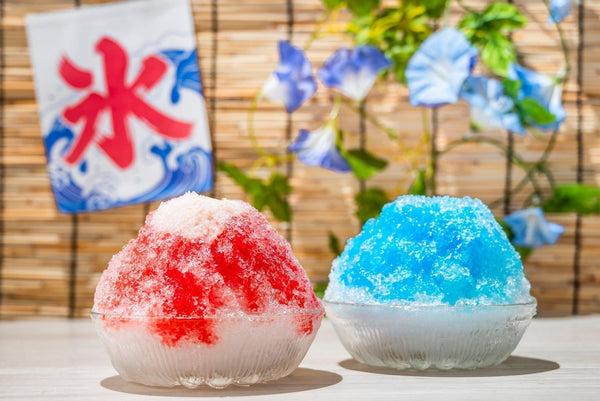
Jump to:
Kakigori is a sweet, frozen Japanese dessert that’s perfect for keeping cool on a hot summer day. Kakigori translates almost directly into “shaved ice” in English.
Kaki means “scrape” or “shave,” and gori means “ice” (coming from the word kōri). Kakigori is served with various flavors of syrups and toppings (and sometimes condensed milk). You might compare it to a snow cone in the US, a raspado in Mexico, or even a bao bing in Taiwan.
Icy desserts are popular in many countries, but Japanese kakigori has some unique qualities (especially in regard to flavors, appearance, and toppings).
Brief History of Kakigori

Kakigori has a long, interesting (and tasty) history. starting all the way back in the Heian Period (794-1185). According to the Japan Kakigori Association, the first mention of it in Japanese literature was in Makura no Soshi (The Pillow Book) by Sei Shonagon, a lady in the Imperial Court of Japan. She considered it elegant to eat kakigori, especially in a metal serving dish. In her era, ice was very expensive, and only the privileged could afford it.
By the Meiji Period (1868-1912), however, kakigori started to become available to everyday people. Machines were invented that could make and shave ice. So, people could buy kakigori at shops in the summer. In fact, according to Waraku Web, the first shop to open in Japan was in Yokohama in 1862. There were even special dishes called korikoppu made specifically for eating kakigori.
By the 1960s, people could make their own kakigori at home (thanks to refrigerators and ice shavers). This is when kakigori with colorful syrups (like red and yellow) became popular at Japanese summer festivals. In the current era, kakigori remains popular, and more ways of eating it keep on being created.
Where to Buy Kakigori
Kakigori is eaten mostly in the summer. That’s because Japanese summers get incredibly hot and humid (mushiatsui in Japanese) and people need some way to cope with the heat. It helps that kakigori doesn’t only keep you cool, though.
Kakigori can be found at various shops (some specializing specifically in kakigori) and at stands in summer festivals (matsuri). Sometimes you can even find kakigori at convenience stores! Most places serving kakigori have a white and blue flag with the character "氷" (kōri - meaning “ice”) in red. Definitely stop by if you see the sign.
Best Kakigori Shops in Japan

There are quite a few shops in Japan with delicious kakigori. TimeOut wrote an in-depth article about 30 great shops to try in Tokyo - some of them with really interesting flavors and toppings. If you’re looking for shops in Kansai (West of Tokyo - including Osaka, Kyoto and Kobe), take a look at this listing. Here are a few you might want to visit:
Tokyo
- Azuki to Kouri - Accomplished chef, Miho Horio, creates amazing kakigori that will astound you! The kakigori is beautiful as well as delicious, and comes with toppings ranging from azuki beans to cream to meringue. There are also seasonal flavors like caramel orange cacao and torched crème brulée (yum!). They also specialize in french toast, if you're interested.
- Ginza Ginger - If you’d like to try kakigori with ginger flavors, this is the place to go. They have ginger confiture (basically a jam), ginger syrups and even shop-made ginger milk. They also have other toppings like milk tea cream, berries and macarons.
- Kohiruan - With some unique flavors like banana, lychee tea and tomato (yes, tomato!), they also have some less adventurous options — matcha, brown sugar and others. There are also cute animal-shaped wafers on some of their kakigori dishes!
Osaka
- Ranran - Wow, kakigori with sweet potatoes! Imozukushi is the recommended flavor, according to the Enjoy Osaka Kyoto Kobe website. It’s “a perfect combination of sweet potato and ice. The fluffy ice is filled with sticky sweet potato paste.” To top it off, it’s served with sweet potato skin caramel sauce.
- Yamato Koori Kayano Ten - This place has both beautiful and delicious kakigori of varying flavors. They carry Western and Japanese flavors and toppings like pistachio, strawberry and butterfly pea jelly (what?).
Kakigori and Shaved Ice Around the World

Many countries around the world enjoy kakigori-like shaved ice. In other places, it has different names — and of course slight differences in flavor, toppings, consistency and presentation. Here are a few examples from countries around the world.
- Korea - Called Bingsoo, it’s similar to kakigori and sometimes topped with beans and chopped fruit — in addition to flavored syrups.
- Taiwan, China and East Asia - Named Baobing, it’s a shaved ice dessert introduced while Japan occupied Taiwan, which later spread into China and other East Asian countries.
- The Philippines - Called Halo-halo, it is made from crushed ice and can include all kinds of toppings — like sugar palm, coconut, plantains, and more.
- Mexico and Parts of Central and South America - Named the raspado, it is shaved ice that can be served with fruit flavored syrups, ice cream, sweetened milk, chili sauce and more.
- US and Canada - Often called a “snow cone,” these are usually served in fruit flavors. In the Baltimore area of the US, marshmallow cream is sometimes used. In Hawaii, it’s referred to as “Hawaiian shave ice” — they often use toppings similar to those served on Japanese kakigori (like mochi and beans).
Kakigori Flavors, Toppings, and Styles

Kakigori comes in so many styles and flavors - and with lots of different toppings. Of course, you can find more basic flavors like lemon, melon and green tea. But, at certain shops you can find more unusual types of kakigori.
Flavors
Flavors for kakigori are mostly in syrup form, but shaved ice with condensed milk is also popular. The syrup is poured over the shaved ice. Some of the most popular flavors are strawberry, green tea, melon, lemon, mango, grape, pineapple and blue Hawaii. How do you describe the blue Hawaii flavor? Most people have trouble with this (don’t worry), but Sora News 24 has a pretty good explanation. It tastes something like a very sweet version of Japanese Ramune soda.
Toppings
There are so many things you can put on kakigori that hardly anything would be considered wrong. It’s an icy dessert that’s very open to experimentation and even artistic expression. But, here are some of the most common toppings you will see on kakigori.
- Fruit - A very common topping — this includes strawberries, orange slices, blueberries, grapes and even melon. Yum!
- Sweet Red Beans - These beans, also known as adzuki beans, are delicious if you don’t mind being a little adventurous. Sometimes bean paste (anko) is also used.
- Mochi - This famous, tender, rice-based topping adds an interesting texture and flavor to kakigori.
- Ice Cream - Yes, ice cream is also served on kakigori. This is a popular topping for shaved ice in some other countries, too (like Mexico’s raspado).
Standard Styles
Kakigori comes in different styles. Some sets of flavors together have become their own particular type of kakigori, and are quite popular. Here are two of them.
- Shirokuma - This type of kakigori is flavored with condensed milk, fruits, mochi and anko (sweet bean paste). Sometimes it also includes raisins.
- Uji Kintoki - This one sounds pretty similar to shirokuma kakigori, but it’s slightly different. It uses flavored green tea syrup (not condensed milk), sweet bean paste, green tea ice cream and mochi. If you’re adventurous, try making this one at home!
Modern and Unusual Styles
Lately, there are lots of new variations on kakigori. Some are very creative. Some use coffee or icing or are even disguised as a cake! Here are a few interesting examples.
- Yakigori - Maybe the most exciting type of kakigori — this one has alcohol in it and is lit on fire! See it getting lit up on YouTube.
- Cake Shaped - It looks like a cake from the outside, but inside it’s kakigori! This one was served in Tokyo at Sebastian’s (which unfortunately closed in February 2023). However, keep a lookout, as other shops may sell it (or you can try making it yourself?)
- Coffee - Love coffee? Well, this one might be for you. Various coffee shops, including Komeda’s Coffee, have seasonal coffee flavored kakigori. Give it a try!
- Kinako Banana - This is not a super common flavor (banana), and it’s served with kinako. Kinako is a roasted soybean flour that some say tastes a little like peanuts.
Kakigori Recipes To Try at Home

If you’d like to try kakigori and don’t feel like going (or can’t go) to a shop or summer festival in Japan, that’s okay! You can make kakigori at home. You’ll just need some toppings and syrup and a Japanese shaved ice machine. A smaller one will do for home use, but, if you’re making (or selling) a lot of kakigori, you might consider getting a bigger professional kakigori machine.
When making kakigori, you can use any toppings you like and even be a little experimental. You could also try one of our recipes, such as Uji kintoki (matcha shaved ice), strawberry kakigori, and melon kakigori!
Kakigori is a must-try summer treat. Cool off, get creative, and enjoy this sweet taste of Japanese tradition!


0 comments